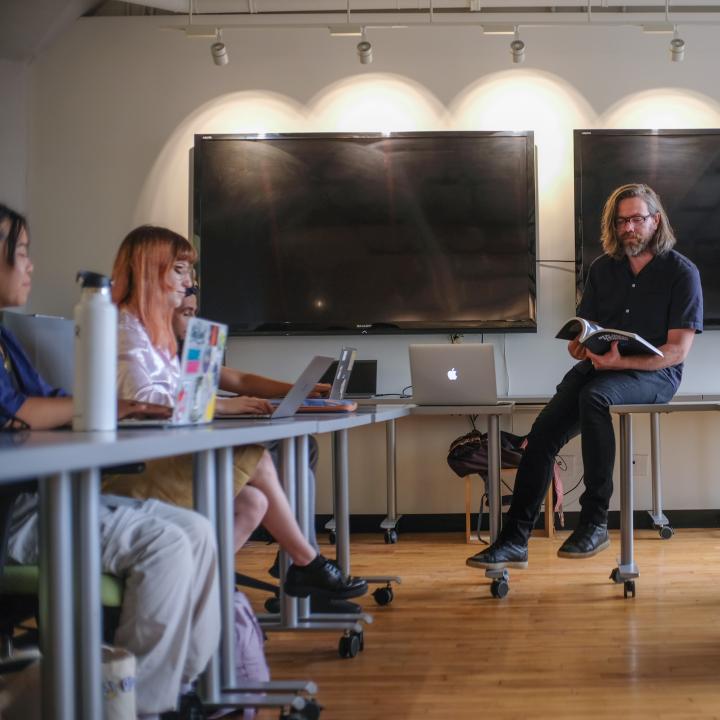Building a strong application
For detailed information about application requirements, please see our Application Requirements page.
Each graduate program will ask you to submit a research proposal or a statement of intent as part of your graduate application. Admissions committee members will read this to get an idea of what you would like to explore in graduate school. Strong research proposals or statements of intent are specific and feasible in their scope and are situated within the broader academic context.
Each program outlines the specific requirements for their research proposal or statement of intent in their program-specific application requirements. Make sure to read the instructions carefully and cover everything that is being asked of you, within the required word length. If you are applying to multiple programs, be sure to tailor your responses to each OCAD U program’s requirements, rather than writing one templated statement and reusing it.
Reviewers want to get a sense of who you are and what you would bring to the program. Let your own voice shine through in the written sections of your application. (It’s fine to use the first person!) Who are you? What to you want to do? Why is this OCAD U program the right place for you to do it? Your research proposal or statement of intent should clearly show that you have researched the program. Make sure to mention what draws you to this program specifically and let the reviewers know why you are applying.
If you’re struggling to decide on a topic or with narrowing down your research interests, try thinking about something you think is a problem, something you are curious about, or a method or technique you would like to explore. These can all be good starting points for finding a research topic. Remember that your research proposal or statement of intent is a draft version of what you would like to accomplish in the program. We expect that you will change and adapt your research in response to your experiences when you begin your studies at OCAD U. Show that your topic is well researched and supported, but not so precise and rigid that you would not be open to refining it.
You will have much more to say than can be covered in the limited word count for the research proposal or statement of intent. Make sure that each word and sentence in your writing is needed; cut out anything that doesn’t serve a purpose or is acting as filler. Provide concrete examples instead of speaking in general terms. Open your proposal or statement with key examples that show the reviewer that this program is the right place for you at this point in your academic and career trajectory.
It is important to situate your proposed research within the greater academic and community context. You should incorporate a few well-chosen references into your research proposal or statement of intent. Make sure that the references you are using are targeted and incorporated well into your writing, rather than simply listing many references to other work without tying them into your proposal or statement. OCAD U recognizes and allows for the use of different referencing styles. Make sure to be consistent in the citation format you are using throughout the written parts of your application.
OCAD U does not aid applicants with writing their research proposal or statement of intent. If you would like feedback on what you have written, your academic recommenders are likely a good resource for assistance. We strongly recommend that you have someone else read over your research proposal or statement of intent to check for errors, review the clarity of your writing, and make sure that it rings true to your voice.
Your portfolio is a representation of yourself and your work which the admissions committee uses to determine how you would fare in graduate school, and specifically your match for the program for which you are applying. Be strategic and thoughtful about how you’re representing yourself in your portfolio. What story do you want to tell about yourself?
The admissions committee wants to learn more about what you’ve done in the past, in terms of the work itself and your process and reflection on the work, and what you want to do in the course. Instead of focusing on what you think the admissions committee would want to see, or what needs to be a part of a “perfect portfolio,” think about what best reflects your interests and capabilities.
If you’re applying without a traditional art or design background, it can be daunting to think of what to include in the portfolio. Rest assured that reviewers aren’t looking for an art or design-based portfolio if you’re not coming from an art or design background. They’re looking for examples of your work and interests as they reflect your capabilities and what you would like to complete in the program. You can think more broadly about what can be included in the portfolio. For example, you could include analytic reports, proposal documents, software, user-experience designs, analysis reports, web applications, and websites.
It can be helpful for the admissions committee to see your process when also viewing your work in your portfolio. Including some process work is a great way to show reviewers how you use your abilities and technical skills to bring a project to fruition.
If you’re including items in your portfolio that are collaborative (where you worked with a team on the project), make sure that you clearly indicate what your role was in the project and the specific parts that you contributed. You could do this in the file itself, or in the description of the item when you upload it into your application.
If you’d love to include some of your past work, but you can’t publicly discuss it due to non-disclosure agreements, you can still reference it in your portfolio or application. Just speak about it in more general terms, mentioning that you can’t state specifics due to non-disclosure rules.
When putting together your portfolio, make sure to be concise. Each application is reviewed by the admissions committee within a short time frame, so be mindful of how much time each reviewer will be able to spend on your file. Provide only your most relevant examples of work, send an example clip of a video project rather than a full hour-long file, limit the number of pages you’re including in a PDF, etc. Similarly, make sure that the items you include are proofread and professional. When quickly reviewing, typos can easily throw off a reviewer.
As with all aspects of your application, it can be helpful to get an outside perspective! If you’re documenting your work, consider hiring someone to document your work, as it can be helpful to have a second person view your work and think about how best to present it in your portfolio. Once you’ve assembled your portfolio, you can also have a colleague, professor, or friend review it. While OCAD U does not offer portfolio reviews at the graduate admissions level, we encourage you to review our Portfolio Guidance Webinar for lots of helpful tips and advice from admissions committee members about what they’re looking for when they review a portfolio!

Ready to Apply?
Hear from OCAD U Graduate Program Directors and faculty as they offer guidance on submitting a strong application.


